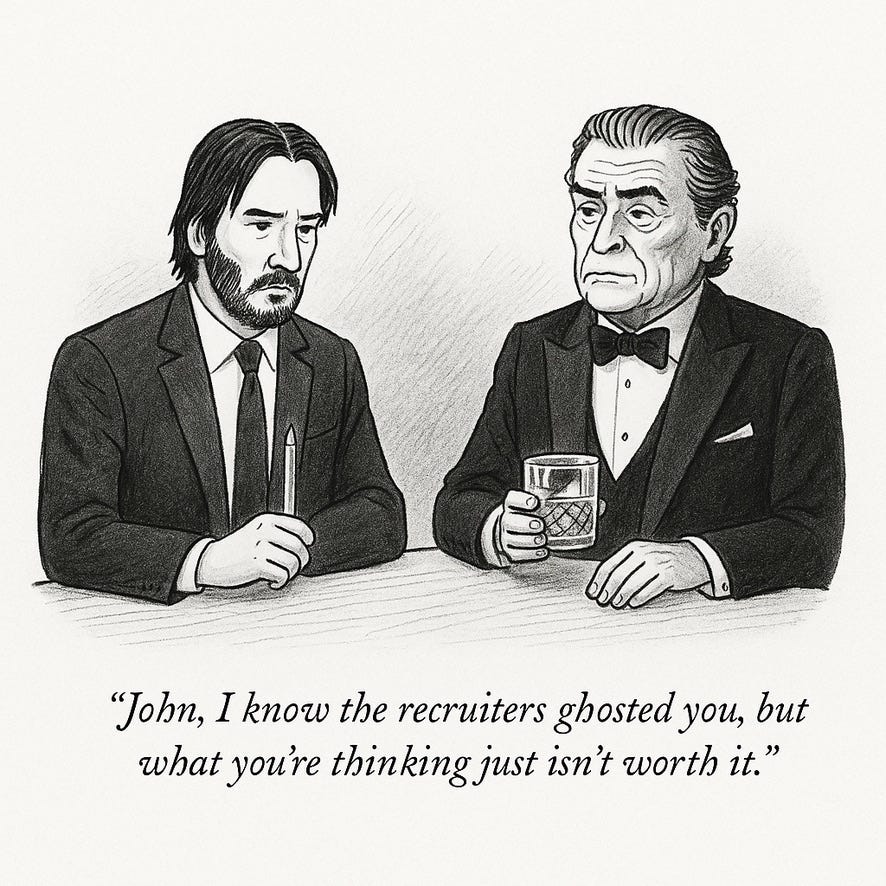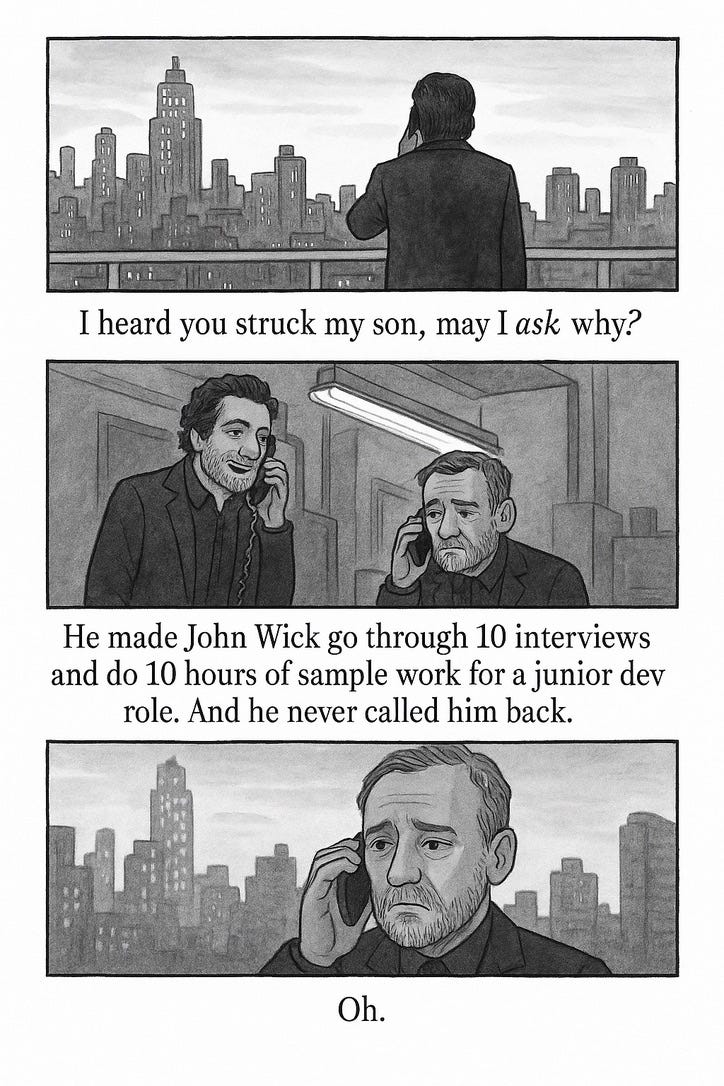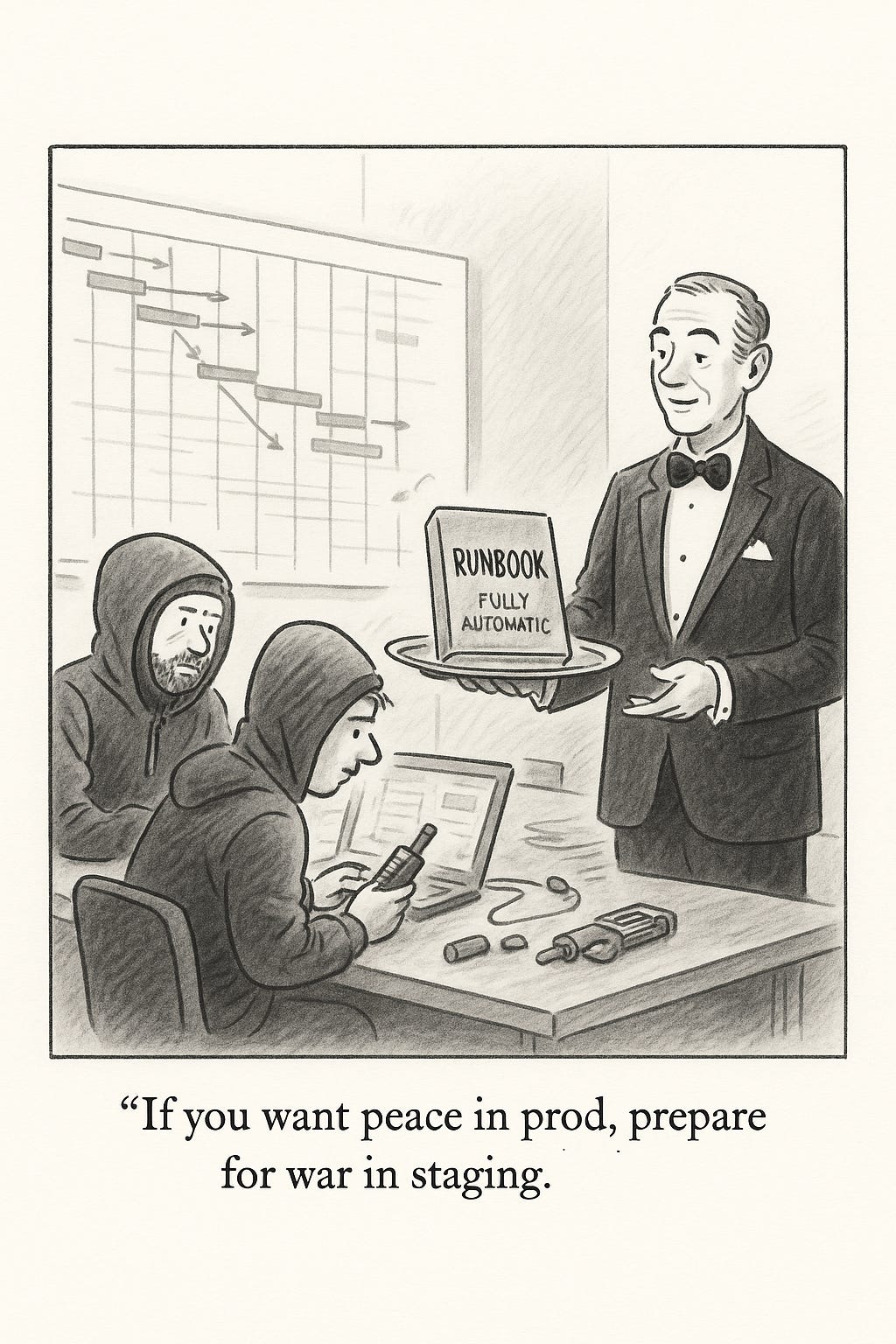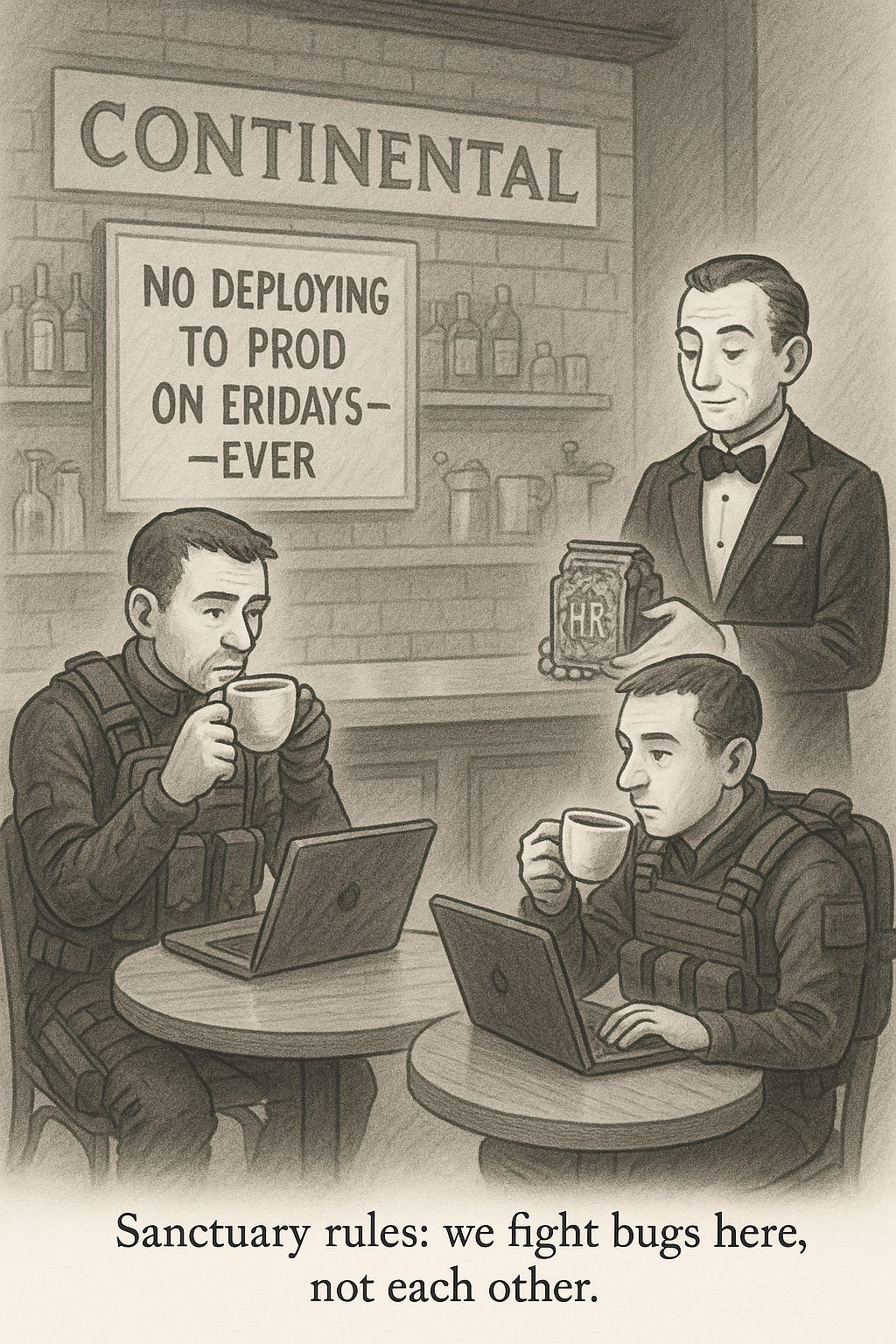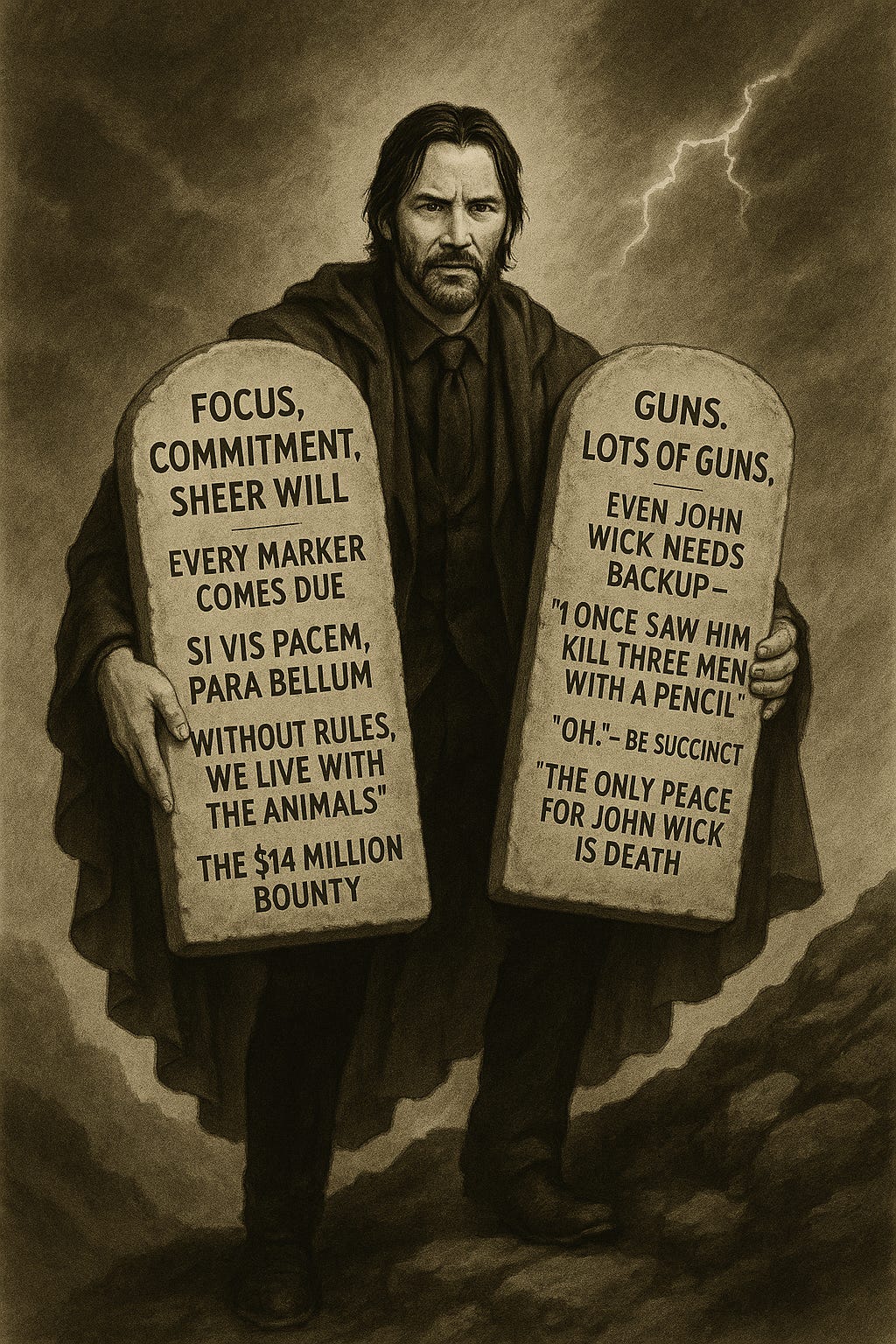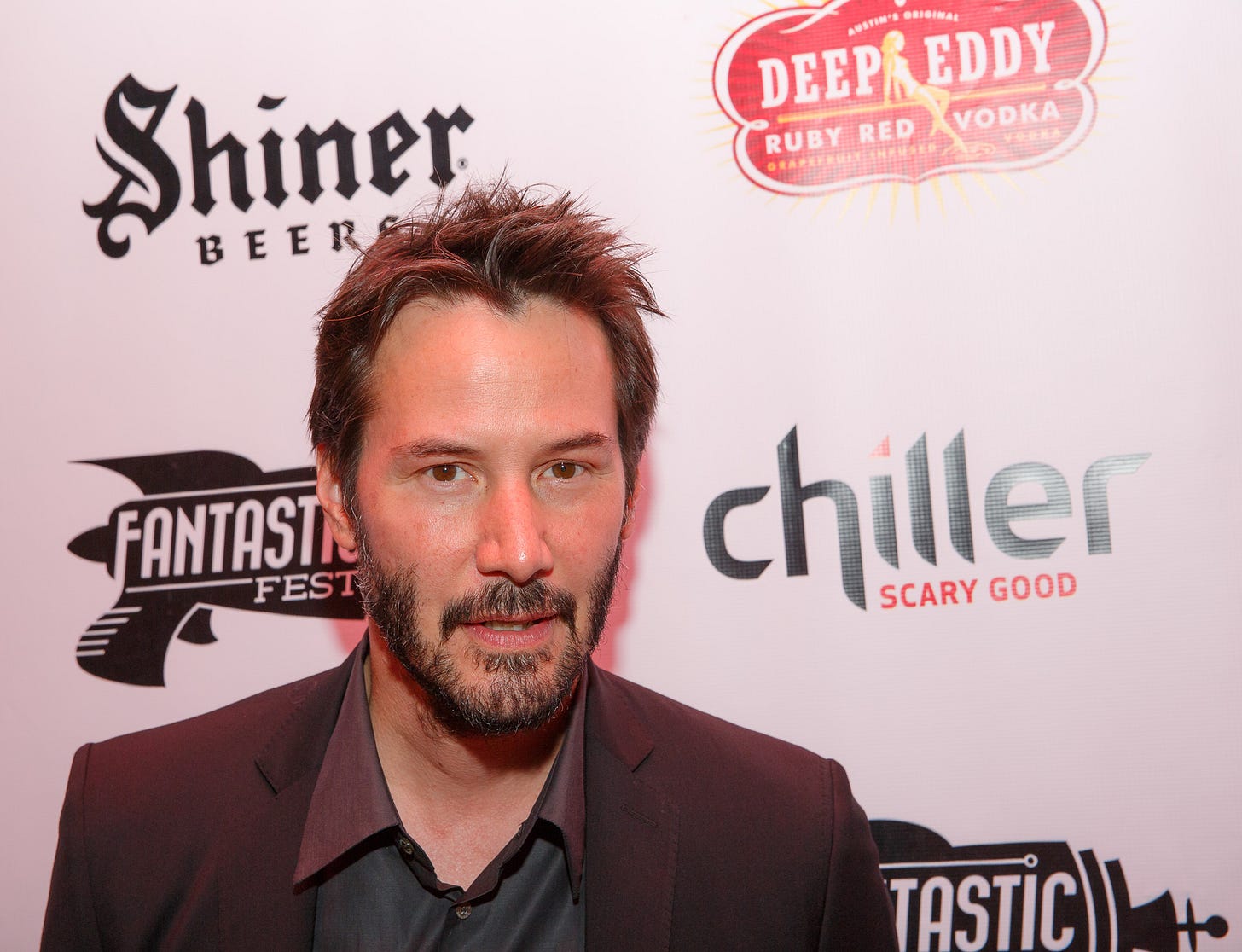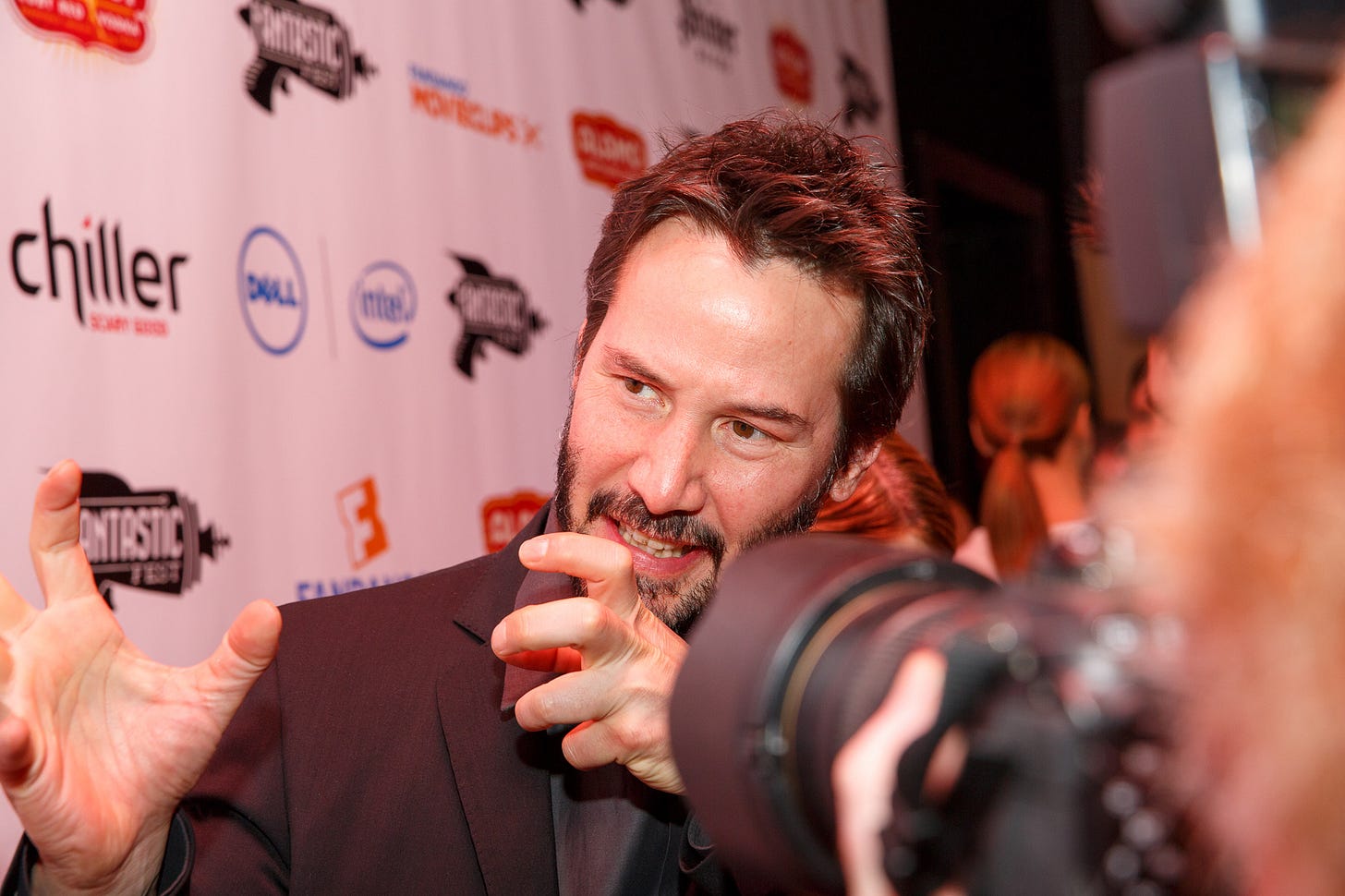Yeah, I'm thinking I'm back
(also) leadership lessons from John Wick…
People Keep Asking If I’m Back, And I Haven’t Really Had An Answer, But Yeah, I’m Thinking I’m Back. - John Wick (John Wick)
What’s this post all about?
This is either an awesome, or a very weird share. It’s half status update, half vulnerable thinking out loud, half awesome/silly leadership lessons movie tie. Next week I suppose I’ll have to follow up with a math lessons or something. ;-)
Time to do something
About a year ago I did something I hadn’t done since, well since before college. I resigned from a job without a new one lined up. I’d hit a point in my current role where I felt responsible leaving, and desired a break. For the first time I put that together and just took the next step.
I did nothing for a while beyond decompressing, and hanging out with my daughter while I still can. She’s 11 and thus somewhat likes me around but also enjoys explaining how “cringe” and possibly “skibidi1” I am. I’m not sure but I suspect that means the clock is ticking quickly towards 100% “go away dad!!!” mode. In the meantime we did some travel, I enjoyed long walks, indulged some hobbies, and caught up with friends. I also updated technical learnings that I wouldn’t have had the time for otherwise.
The extra learning has been especially fun, particularly the time spent with new coding tools. I was reflecting on the upwards abstraction trajectory of tools over my working life. From Assembly→C→C++→ insert languages that mange memory→ cloud and distributed systems→Today’s AI/Agentic systems. I have to say it’s nice to not have to even keep track of which packages to install. Among other more impressive things. Pair programming (not to mention TDD) feels like it truly comes into its own when your partner is a machine. Even if the machine sometimes acts like an amped up new hire that doesn’t have context on anything yet. The future seems bright - though hopefully not “end of the world destruction blast” bright. We do again live in interesting times.
I’d really love the help of folks in my network exploring what to do next professionally. Here's my best, current take on the two categories of things I'm thinking about:
In terms of full time roles I’d be most interested in something where I could hear and help influence company or org decisions. The Goldilocks case of this probably looks like a CTO/VP engineering/GM role where product + science + engineering need to work fluidly together. I’d expect I'd deliver the most bang for your buck at a later series B through pre/post IPO company. Where there’s both some scale (leader of leaders) but also messy cross-disciplinary challenges that call for separating things into solvable chunks, prioritizing and delivering measurable results.
I’m also curious in a way I haven’t been before about Consulting/advisor/fractional basis gigs. I’m pretty good at helping folks with messy problems achieve clarity of direction, sort through thorny org issues, set great goals, or just provide an external view on how things are operating and/or generate new technical options.
I’d appreciate introductions, feedback, advice, hot tips, or just time hanging out. Whether in person in the Seattle area or over Zoom. I’m excited to jump back in, but thankfully also privileged in having the time to really try to nail the match.
</end personal marketing section>
.
.
To reward you for reading this far, with the upcoming release of Ballerina2 I was inspired to do something silly. Which is why I’ll now share some leadership lessons from the world of John Wick. If you know anyone from Lionsgate Films who’s interested in sponsoring content (or just sending me swag) please forward this their way. ;-)
I know I labeled this as silly - but I feel there’s useful stuff tying into what I’ve been writing about.
Warning: Spoilers ahead for the movie and (maybe) for how to make your work life a bit better.
Management Lessons from John Wick
This week I realized with a jump of excitement that it’s almost time for the newest installment in the John Wick franchise - Ballerina. I explain in the postscript how I have a personal connection to the films. It’s not that I entertain an interest in a road not taken career as an assassin.
Without further adieu, I present ten leadership lessons from the John Wick universe than can be applied to the modern workplace. Mostly HR acceptable, let’s go ahead and channel a little Baba Yaga energy together…
(Spoiler warning for the John Wick series, but if you haven’t seen the films yet…)
1. “Focus, Commitment, Sheer Will” - Relentless Execution on Clear Goals
John Wick is described as a man of “focus, commitment, sheer will.” When the cardinal sins of murdering his puppy and stealing his Mustang (car) occur he goes to work with complete focus and truly ruthless prioritization.
As I’ve shared earlier in my setting clear OKR’s article, that combined with prioritization is the essence of successful execution. Figure out what the bottleneck is in your system3, set input goals that help deliver value, and go to work. Come to think of it Goldratt’s Theory of Constraints (identify the bottleneck, exploit it, subordinate non-constraints to the constrain, elevate the constraints, repeat the process) is similar to the relentless focus John demonstrates.
Once you have clear OKR’s to align focus, then the manager’s job is to defend the path from distractions, clear blockers from the team, and reducing multitasking whenever possible. Done right your customers will love you the way his targets fear the Baba Yaga.
2. Every Marker Comes Due - Honor commitments and Technical Debt
“Shipping first time code is like going into debt... The danger occurs when the debt is not repaid” - Ward Cunningham
John Wick having eliminated everyone in his wake in the first film is pulled back into the business (Godfather 3 style) by a blood marker signifying an unpaid commitment. He initially balks only to have his beautiful house vaporized. Thank goodness the dog comes out better this time.
Teams routinely take out tech debt against their future, often with an explicit or implicit agreement with other teams/management/The Table on how and when it will be repaid. Sometimes those blood oaths are honored, sometimes they’re not. Danger lies in ignoring obligations.
I’m NOT suggesting you take a rocket launcher to your manager’s office if you feel they ignored an agreement to clean things up “post launch.” Instead take another read through my Meditations on Tech Debt for ideas on how to productively have that conversation without the need to resort to violence. Ignoring tech debt’s drain on throughput and ignoring commitments to measure and reduce it can result in a compounding problem that even John Wick couldn’t breeze past.
Keeping up with obligations transcends tech debt - it’s key to earning trust with your team, and others. Treat commitments as sacred - either to be carried out or re-discussed in the light of new (possibly disconfirming) information. Trust is hard to build and easy to lose - it’s better to say “No” and build confidence than say yes to everything and assume those markers won’t come due later.
3. Si vis pacem, para bellum - Ensure the Peace by Preparing for War
“Si vis pacem, para bellum” Latin for “If you want peace, prepare for war,” this slogan gives John Wick: Chapter 3 - Parabellum its title. Similarly, there’s huge value in planning for failure to prevent painful problems. I began the discussion on this in This is not the culture you’re looking for. A powerful tool for this is the pre-mortem. Gather the team in advance of the launch and ask them to project their thinking into the future. It’s 3 months from launch and things have gone badly wrong! What caused the issues?, what can we do now to either prevent them?, or detect them faster if they happen? Other steps in the “preparing to be wrong” canon4 include
Ensuring you have answered basic deployment questions early, including; how will you know something went wrong?, how/can you rollback to a safe state?, and who is responsible for initial monitoring5?
A review of your monitoring and alarming plan. Test the alarming actually goes off. Seriously. Ask me why I’m so insistent about this point.
Have runbooks that someone awoken in the middle of the night can use to diagnose and stabilize a problem.
Have a plan in advance for how the team works through major issues on a live call. It’s not as easy as it seems to do well.
Run a gameday (basically a virtual wargame) when you break something on purpose under controlled conditions and work through it as a team.
Bake resilience into your design reviews assuming failure will happen and confirm you’re design will function gracefully. If you design for graceful failure MAKE SURE YOU TEST IT WORKS AS EXPECTED. Again, ask me why I’m so insistent.
Just like John and his partners armoring up at the Continental, or stashing guns along an exit route while advancing through a tunnel in Rome - if you plan for chaos proactively you’ll be better prepared when it (inevitably) happens. The chaos will seem turned down in volume as you shift from the need for heroics towards training and prepping in advance.
Just because you’re paranoid doesn’t mean everyone isn’t out to get you. Murphy’s Law is really real, and paranoia makes for better systems.
4. “Without Rules, We Live with the Animals” - Build a Culture of Trust and Consequences (aka learning)
The world of John Wick has complex rules that govern relationships and acceptable actions. The rules are black and white - gray does not exist; no conducting “business” on hotel grounds, the need to honor markers, obeying the dictates of the “high table” etc. While I wouldn’t recommend something so dogmatic, having intentionally shaped expectations helps the team succeed.
Whatever you do will become your culture, and if that culture defers to the most senior person in the room, punishes failure, or protects the team’s image as a first priority - then you’re going to have negative consequences. I recommend you document your team tenets, processes and expectations.
Ultimately you need to live your code in a visible way. Whatever you do is what’s real - independent of what’s on the posters on the wall. I’ve covered some additional aspects of what’s important to a healthy culture in Fix the Problem, not the Blame and Management and Culture Checklists.
The Continental serves as a safe space regardless of the guest’s actions outside the hotel. I’m not sure you want to go so far as having a spot to pause for a drink before resuming trying to kill each other - but if John Wick has a spot for psychological safety then it’s probably important to provide for your team as well.
5. The $14 Million Bounty - Incentives Drive Behavior (for Better or Worse)
John is having a bad day even before a huge bounty is placed on his head. In Chapter 3, a $14 million open contract turns every cab driver, violinist, and housing challenged individual in New York into a part-time assassin. You’ve got to wonder who’s doing the laundry and other basic tasks when it looks like everyone in NYC is a gun for hire. The poetic license aside, It’s a vivid example that people and systems respond to incentives. Give enough people enough rewards to accomplish something and you’ll be amazed, though sometimes also aghast at the ingenuity that’s deployed to achieve “success.”
Culture sets incentives both intentionally and unintentionally. Think hard about what behavior you want. Consider 2nd and 3rd order effects, including what can go pathologically wrong with your goals/incentives. It’s often smart to set counterbalancing goals alongside your main KPI’s.
Incentives come in many forms - bonuses, promotions, and public recognition. A misaligned incentive can send dozens of well-meaning team members charging in the wrong direction. If you reward heroics, or building shiny new systems you’ll likely get more situations that need heroics and lots of new systems.
In my career before Amazon I worked at a company that told us they’d pay a bounty of $50 (or maybe it was more) per patent idea written up. I suggested that this perhaps wasn’t a great idea - the company didn’t get value directly from patents, it wasn’t enough to drive people to change their thinking deeply, but a LOT of disclosures might be worth something now that there was cash involved. That wasn’t viewed as “helpful feedback.” I’m not saying I’m proud of this story - but I will say that my small, creative R&D team didn’t pay for lunch again for at least a full quarter. Since each disclosure cost the company time in indirect costs (reviewing them) and direct costs (deploying lawyers on them) it’s probably a good thing that my corporate disobedience caused the program to be paused. Again - I’m not proud of this, and I’m sure you’re thinking “I’d never do anything so silly” - but companies and people do this all the time.
If you reward people focusing ruthlessly on hitting goals without ever changing them, it’s likely they’ll continue in some goal that’s no longer useful. Unconsciously ignoring contradicting information when it comes up. If people take “leadership direction” as if it’s a High Table decree then you’re gonna commit some whopper blunders.
6. “Guns. Lots of Guns.” - Equip Your Team with the Right Tools
At a key moment, facing overwhelming odds, Winston asks John, “What do you need?” John’s answer in Chapter 3 is delivered with a smirk - “Guns. Lots of guns.” He knows the value of the right tool for the job (and possibly a few more for good measure)6. The creators of the films also know the value of product placement - being the only franchise I can think of with what feels like an explicit commercial in the midst of most of them for a specific weapon you can bring home in many states (example below)7.
From a practical management perspective you need to ensure that your team is armed with the tools to do the job. Properly powerful laptops, fast bandwidth, tokens for coding agents, caffeine - whatever it takes. There’s rarely a magical tool that can compensate for poor ideas and sloppy engineering. You’re not going to become a piano maestro because you started on a Steinway vs. a Casio keyboard. Skills come from intentional practice and learning from failure, but as you develop your craft the tools may become the limiting factor (or fail under heavy use). I’m assuming you’re paying top dollar for the best craftspeople of software and systems. Don’t skimp on the right tools when they’re needed.
John Wick is deliberate in choosing the right tool at the right time (pistol, knife, shotgun, pencil). Tech teams need the same fluidity in choosing the right option for the problem. Just like you don’t want to bring a knife to a gunfight8 you don’t want to be using a heavyweight COE process when “well that sucked, let’s not do that again” will do. Lots and lots of companies suddenly insist on breaking up their giant monolith into too many micro-services when some basic separations of concerns and not using the database as the damned API will do.
There are times when it’s worth standardizing everyone on the same tools - and I’ll get into that someday (sooner if folks ask). But otherwise I suggest choosing the tools for the job you have, not necessarily for some ivory tower ideal that you may never have to deal with.
7. Even John Wick Needs Backup - The Power of Allies and Support Systems
No one is an island. John Wick may seem like the epitome of a lone wolf, but if you observe closely he rarely operates fully alone. His alliances are based on earned respect and (possibly) friendship, and are what let him make it through the epic bloodbath of the films. Winston defies the rules to give him a head-start, the Bowery King provides intel, safe passage and a weapon, Sofia fights by his side and Charon risks his life to fight with him.
No matter how fully decoupled you think you and you team are, you’re probably wrong. Your goals without outside input and support may focus overly on local vs. global achievements. Ideas are better with external partners to brainstorm with. While you’ll likely not catch a pencil to the eye in your workplace, even the best cultures are enhanced when you have great relationships across the company. You may not need someone to keep an eye out for being knifed in the back - but deeply understanding the needs of many different functional areas (not to mention your customers) are likely to 10x the quality of your ideas - and hence your impact.
Form relationships before you need them. This pays dividends down the road and often in unexpected ways. Just being curious about things will usually teach you something valuable for the future - but that curiosity also tends to build confidence in you and trust. If you’ve done that with an attitude of collaboration and respect people will jump in when you need them.
8. “I once saw him kill three men with a pencil” - Resourcefulness Under Constraints
As the legend goes Mr. Wick once killed three men in a bar with a pencil - “with a f***ing pencil!” Throughout the series John Wick displays resourcefulness under imposed constraints. A pencil, a book, or even a horse can be a weapon when it’s what you have to work with.
In addition to driving creativity the constraint itself is also a signal as to where to concentrate. I’m extremely fond of the writing of Eliyahu Goldratt and his Theory of Constraints - which go way beyond his book The Goal. If you can find what’s the thing that’s holding you back the most, you’ll often find it’s a single thing that if you had more of you’d be able to produce more of what’s important to your business (more profit now and in the future, more customers, happier employees, etc). It’s a powerful but simple way to cut through what prioritization really matters, vs. overcomplicating everything.
Constraints are a little different in this example though. If you’re John Wick you could find yourself at a bar with no traditional weapon - just a pencil and perhaps some anger that the service just wasn’t really worth the mandatory 35% service fee.
When things look dire and you feel you don’t have the resources to solve a problem -
ask yourself “what would have to be true for us to win in this situation,
and what would prevailing look like to us?”
This mental trick can unleash problem solving rather than feeling stuck in the problem. Things are rarely as good or as bad as they seem in a moment - and perhaps that pencil is more useful than you think it is at first glance.
Most engineers have some story they like to share at parties about how they didn’t have the time to write a bunch of fancy code so they tallied some numbers to get a rough estimate (with a pencil and a napkin). Or maybe a tight budget (or some billionaire firing people at random) kept them from buying the latest tool so they ran the code for the nuclear reactor in Emacs. That ability to get by with limited resources may not always be the way you want to have to play it. But doing so often is what makes you legendary.
Wick’s ability to kill with a pencil is a testament to not just his MacGyver mindset but his intense skill building. The stronger a team is on the fundamentals the more they can flex to unfamiliar environments using those core problem solving skills.
9. “Oh.” - Once you understand the situation - be succinct
I am rarely a man of few words. But when I’ve got clarity on something - say two goals that empower deep alignment my language can suddenly get clear and direct. Even though I often think outloud, that’s not to say I don’t see the the benefit of being able to express oneself with brevity. Some of the most communicative moments of the John Wick universe are extremely sparse in spoken language.
A lot gets said between the lines. Whether it’s Viggo understanding a complex situation and what was about to happen with one word, or John Wick hanging up the phone on Viggo’s entreaties with clarity not seen since Peppa Pig and the infamous whistling episode.
Viggo: I heard you struck my son.
Aurelio: Yes, sir, I did.
Viggo: And may I ask why?
Aurelio: Yeah, well, because he stole John Wick's car, sir, and, uh, killed his dog.
Viggo: [pause] Oh.
You may require a lot more context for your team than this to make decisions autonomously. Setting up the backstory as clearly as possible lets future communication achieve fabulous efficiency.
Clear writing is clear thinking. Once you all understand the vision of the future desired, and document key things like goals and tenets, then you can express a lot rather briefly going forward.
10. “The only peace for John Wick is Death”: Focus beyond the workplace
While I might have been reaching on some of these “lessons” - this last one is probably a real stretch from the film’s themes. As entertaining as the movies are, there are only so many likely outcomes for John Wick. But then again - we all are going to that same place in the end.
We spend our time budget without ever knowing how large the remaining balance is. As critical as work can feel, in the long run it’s pretty unlikely “the job” is the thing you should expend all your sheer will and focus on. Ask yourself if at 80 you’re likely to crave another bunch of money or another few healthy years and you’ll see what I mean.
If John Wick had stepped back and built a vision for himself about what else was worth fighting for beyond a nihilistic revenge the films would have been very different. Yes - also less fun. Thankfully for us (and the investors) the writers didn’t go that way. But that’s an important lesson for the rest of us to take away.
BTW - if you’re on the verge of curing cancer or something like that - please disregard my advice and keep the sheer will dialed up to 11 until you succeed. Also - thanks in advance on behalf of humanity!
Final Chapter - “Yeah, I’m Thinking I’m Back”… to the point of all this
John Wick’s saga of revenge and redemption is hopefully more intense than our daily work and personal lives. Beneath the most excellently entertaining gun-fu choreography lie solid lessons for anyone leading teams or building systems. The common thread through these is intentionality - whether it’s in how you focus your team, design incentives/targets, prepare for risks, or support your people. John Wick doesn’t do half-hearted, and that’s a challenge to all leaders: be deliberate, be prepared, and lead with a clear code (tenets).
Be the person of focus, commitment, and sheer will you want to be. And give your puppy an extra hug from me in the meantime.
Don’t forget - Ballerina hits the big screen the week of 6/25. Hopefully I’ll see some of you in the theater. Lionsgate - you’re welcome!
Postscript
A bonus story about my personal connection with the film John Wick.
I used to regularly attend the best film festival on earth, FantasticFest - accurately described as a film festival with the boring parts cut out. Held at the Alamo Drafthouse Theater on Lamar Street in Austin it showcases roughly ten days of amazing genre films, parties, and themed activities. I never made it the full ten days, but always had pure fun for whatever time I had.
In 2014 they premiered the film John Wick. I’d heard nothing about going in9. I saw the first screening with a packed house of 500+ super amped up genre film fans. The directors and star were in attendance, people were pumped, and the crowd went wild from beginning to end. It was truly a blast.
As an added bonus it was one of the events where I was acting out my secret life as a red carpet photographer. As a sometimes movie blogger and amateur photographer (originally mostly wildlife and sports kid photography) I’d been talking my way into red carpet shoots for a while at this point. I grew up a very shy kid, and as an adult worked on being able to talk to people I didn’t know without freaking out. As I got better at that I guess I looked for a bit more challenge, and on a lark at some event I tried to talk folks into letting me shoot the red carpet - and it worked out.
I think I did pretty well at it, shooting events at the Seattle International Film Festival, FantasticFest and SXSW. It’s been a while, but when I was writing this up I remembered I’d shot some photos of the event for IMDb - which I worked at the time. Thank you again Brandy Fons for that!
I have to admit it was a much easier getting credentialed as media/photographer when I ran Consumer Site tech for the largest movie website on earth. Though that job didn’t stop my own staff from (with no plausible justification) warning me not to talk to Brie Larson when she did some interviews with the team outside my office. But that’s a story for another day. ;-)
I’d like to think I made that word up, but I did not. Best I can tell it’s only slightly less polysemous than “Smurf” was in those cartoons. Though seemingly always negative? Yes - I had to look up polysemous too.
As I was writing I watched the BTS documentary Wick is Pain about the making of the films. I normally don’t seek out “making of” work that doubles as an ad for the newest film in the franchise. But the folks who made John Wick and their career stories are almost as engaging as the films. Highly recommend.
Bottleneck = what if you had more of you’d get more of the outputs you most care about; profit, customers retained, etc.
If you’re not familiar with the WRAP framework from Decisive I definitely recommend checking it out.
Also - check that the main devs aren’t going home and leaving their laptops at the office post deployment. Ask me about that true story when we meetup next.
Yes - also the value of fan service callback to the same line in The Matrix. Fun fact - at one point so much of IMDb’s monitoring was supposedly centered on that film’s title page that folks joked it was possible the whole site could be down and no one would notice. Not a great example of functional monitoring - but a memorably homage to the groundbreaking film.
I know there are lots of other iconic guns from films that have driven demand. Die Hard’s Beretta 92 pistol, and the beloved “now I have a machine gun” HK MP5 are famous examples. But as far as I know only John Wick gets a character to deliver a few marketing lines in each film about that picture’s special weapon. Usually available as the film is released.
Yeah - I know, different film. sorry!
The backstory about the film’s breakout from FantasticFest appears in the BTS John Wick is Pain. It brought back a lot of memories - and watching the footage I’m literally like one person off from a lot of the action there. I think my camera flash actually made it onscreen at some point. ;-) Would have been my second appearance in BTS footage after me standing on line to watch a midnight screening of Big Ass Spider in the Blu-ray extras.


